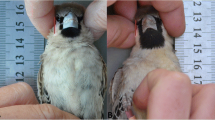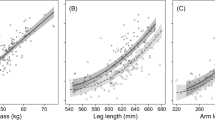Abstract
We investigated the existence of a social dominance hierarchy in the captive group of six adult bonobos at the Planckendael Zoo. We quantified the pattern of dyadic exchange of a number of behaviors to examine to what extent each behavior fits a linear rank order model. Following de Waal (1989), we distinguish three types of dominance: agonistic dominance, competitive ability and formal dominance. Fleeing upon aggression is a good measure of agonistic dominance. The agonistic dominance hierarchy in the study group shows significant and strong linearity. The rank order was: 1. female (22 yr), 2. female (15 yr)., 3. male (23 yr.), 4. female (15 yr.), 5. male (9 yr.), 6. male (10 yr.). As in the wild, the females occupy high ranks. There is prominent but nonexclusive female agonistic dominance. Teeth-baring does not fulfil the criteria of a formal submission signal. Peering is a request for tolerance of proximity. Since its direction within dyads is consistent with that of fleeing interactions, it is a useful additional measure to determine agonistic ranks in bonobos. In competitive situations, the females acquire more food than other group members do. The rank obtained from access to food resources differs from the agonistic rank due to female intrasexual social tolerance, expressed in food sharing. We typify the dominance styles in the group as female intrasexual tolerance and male challenging of rank differences. The agonistic rank order correlates significantly with age and has a strong predictive value for other social behaviors.
Similar content being viewed by others
REFERENCES
Alcock, J. (1984). Animal Behaviour: An Evolutionary Approach, 3rd. ed., Sinauer Associates, Sunderland, Massachusetts.
Altmann, S. A. (1974). Observational study of behavior: Sampling methods. Behaviour 49: 227-267.
Appleby, M. C. (1983). The probability of linearity in hierarchies. Anim. Behav. 31: 600-608.
de Vries, H. (1995). An improved test of linearity in dominance hierarchies containing unknown or tied relationships. Anim. Behav. 50: 1375-1389.
de Vries, H., Netto, W. J., and Hanegraaf, P. L. H. (1993). Matman: A program for the analysis of sociometric matrices and behavioural transition matrices. Behaviour 125: 157-175.
de Waal, F. B. M. (1982). Chimpanzee Politics, Jonathan Cape, London.
de Waal, F. B. M. (1987). Tension regulation and nonreproductive functions of sex in captive bonobos (Pan paniscus). Natl. Geogr. Res. 3: 318-335.
de Waal, F. B. M. (1988). The communicative repertoire of captive bonobos (Pan paniscus) compared to that of chimpanzees. Behaviour 106: 183-251.
de Waal, F. B. M. (1989). Dominance ''style'' and primate social organization. In Standen, V., and Foley, R. A. (eds.), Comparative Socioecology, Blackwell, Oxford, pp. 243-264.
de Waal, F. B. M. (1992). Appeasement, celebration, and food sharing in the two Pan species. In Nishida, T. (ed.), Human Origins, Topics in Primatology. Vol. 1, Tokyo University Press, Tokyo.
de Waal, F. B. M. (1996). Good Natured: The Origins of Right and Wrong in Humans and Other Animals, Harvard University Press, Cambridge, Massechusetts, p. 296.
de Waal, F. B. M. (1997). Bonobo: De vergeten mensaap: Natuur en Techniek. Beek, Nederland. p. 210.
de Waal, F. B. M., and Luttrell, L. M. (1985). The formal hierarchy of rhesus monkeys: An investigation of the bared-teeth display. Am. J. Primatol. 9: 73-85.
Drews, C. (1993). The concept and definition of dominance in animal behaviour. Behaviour 125: 283-311.
Franz, C. (1998). Female Dominance and Related Behaviour Patterns in Bonobos (Pan paniscus), Karl-Franzens-Universität Graz, Austria. Dissertation.
Fruth, B., and Hohmann, G. (1997). Sociality in Bonobos: the Males' Role. Paper presented at the First Göttinger Freilandtage on Primate socioecology: Causes and consequences of variation in the number of males per group. Deutsches PrimatenZentrum, 9-12 December 1997.
Furuichi, T. (1989). Social interactions and the life history of female Pan paniscus in Wamba, Zaïre. Int. J. Primatol. 10: 173-197.
Furuichi, T. (1992). Dominance Relations Among Wild Bonobos (Pan paniscus) at Wamba, Zaïre. Abstracts of the XIVth Congress of the International Primatological Society, Strassbourg, 16-22 August, France. Abstract 301.
Furuichi, T. (1997). Agonistic interactions and matrifocal dominance rank of wild bonobos (Pan paniscus) at Wamba. Int. J. Primatol. 18: 855-875.
Furuichi, T., and Ihobe, H. (1994). Variation in male relationships in bonobos and chimpanzees. Behaviour. 130: 211-228.
Goodall, J. (1986). The chimpanzees of Gombe, Harvard University Press, Cambridge, Massachusetts.
Hinde, R. A. (1974). Biological Bases of Human Social Behaviour, McGraw-Hill, New York.
Hohmann, G., and Fruth, B. (1993). Field observations on meat sharing among bonobos (Pan paniscus). Folia Primatol. 60: 225-229.
Hohmann, G., and Fruth, B. (1996). Food sharing in wild bonobos (Pan paniscus): The sex for food hypothesis reviewed. Primate Rep. 44: 22.
Idani, G. (1991). Social relationships between immigrant and resident bonobo (Pan paniscus) females at Wamba Folia primatol. 57: 83-95.
Ihobe, H. (1992). Male-male relationships among wild bonobos (Pan paniscus) at Wamba, Republic of Zaire. Primates 33: 163-179.
Jordan, C. (1977). Das Verhalten Zoolebender Zwergschimpansen, Inaugural Dissertation, Johann-Wolfgang-Goethe Universität zu Frankfurt am Main, Fronkfurt, Germany.
Jungers, W. L., and Susman, R. L. (1984). Body size and skeletal allometry in African apes. In Susman, R.L. (ed.), The Pygmy Chimpanzee, Evolutionary Biology and Behavior, Plenum Press, New York, pp. 131-178.
Kano, T. (1980). Social behavior of wild pygmy chimpanzees (Pan paniscus) at Wamba: A preliminary report. J. Hum. Evol. 9: 243-260.
Kano, T. (1992). The Last Ape: Pygmy Chimpanzee Behavior and Ecology, Stanford University Press, Stanford, California.
Kano, T. (1996). Male rank order and copulation rate in a unit-group of bonobos at Wamba, Zaire. In McGrew, W. C., Marchant, L. F., and T. Nishida, Great Ape Societies, Cambridge University Press, Cambridge, UK, pp. 135-145.
Kappeler, P. (1993). Female dominance in primates and other mammals. In Bateson P. P. G. et al. (eds.), Perspectives in Ethology, Vol. 10: Behavior and Evolution, Plenum Press, New York.
Kuroda, S. (1984). Interactions over food among pygmy chimpanzees. In Susman, R. L. (ed.), The Pygmy Chimpanzee, Evolutionary Biology and Behavior, Plenum Press, New York, pp. 301-324.
Leus, K., and van Puijenbroeck. (1996). Studbook of the Bonobo (Pan paniscus), Royal Zoological Society of Antwerp, Belgium.
Martin, P., and Bateson, P. (1993). (2.ed.) Measuring Behaviour, Cambridge University Press, Cambridge, UK.
Nishida, T. (1979). The social structure of chimpanzees of the Mahale mountains. In Hamburg, D. A., and McCown, E. R. (eds.), The Great Apes, Benjamin Cummings Publishing Company, Menlo Park, California, pp. 73-121.
Nishida, T. (1989). Social interactions between resident and immigrant female chimpanzees. In Heltne, P. G., and Marquardt, L. A. (eds.), Understanding Chimpanzees, Harvard University Press, Cambridge, Massachusetts, pp. 68-89.
Noë, R., de Waal, F. B. M., and van Hooff, J. A. R. A. M. (1980). Types of dominance in a chimpanzee colony. Folia Primatol. 34: 90-110.
Parish, A. R. (1994). Sex and food control in the uncommon chimpanzee: How bonobo females overcome a phylogenetic legacy of male dominance. Ethol. Sociobiol. 15: 157-179.
Parish, A. R. (1996). Female relationships in bonobos (Pan paniscus). Hum. Nat. 7: 61-96.
Pusey, A., Williams, J., and Goodall, J. (1997). The influence of dominance rank on the reproductive success of female chimpanzees. Science 227: 829-831.
Richards, S. M. (1974). The concept of dominance and methods of assessment. Anim. Behav. 22: 914-930.
Rowell, T. E. (1974). The concept of social dominance. Behav. Biol. 11: 131-154.
Stanford, C. B. (1998). The social behavior of chimpanzees and bonobos. Curr. Anthropol. 39: 399-420.
Syme, G. J. (1974). Competitive orders as measures of social dominance. Anim. Behav. 22: 931-940.
van Hooff, J. A. R. A. M., and Wensing, J. A. B. (1987). Dominance and its behavioral measures in a captive wolf pack. In Frank, H. W. (ed.), Man and Wolf, Junk Publishers, Dordrecht, The Netherlands, pp. 219-252.
Vervaecke, H., de Vries, H., and van Elsacker, L. (1999). An experimental evaluation of the consistency of competitive ability and agonistic dominance in different social contexts in captive bonobos (Pan paniscus). Behaviour 136: 423-442.
Vervaecke, H., de Vries, H., van Elsacker, L., and Verheyen, R. Support in conflict in captive bonobos. (In prep a).
Vervaecke, H., de Vries, H., and van Elsacker, L., and Verheyen, R. (In prep b). The pivotal role of rank in grooming and support behavior in a captive group of bonobos (Pan paniscus).
Vervaecke, H., van Elsacker, L., and Verheyen, R. F. (1996). The Power of Bonding in Bonobos. XVIth Congress of the International Primatological Society. 11-16 August, Madison, Wisconsin.
White, F. (1992). Food sharing in wild pygmy chimpanzees (Pan paniscus). In Roeder, J. J., Thierry, B., Anderson, J. R., Herrenschmidt, N. (eds.), Current Primatology, Vol. 2, Social Development, Learning and Behavior, Université Louis Pasteur, Strassbourg, France, pp. 1-10.
Author information
Authors and Affiliations
Rights and permissions
About this article
Cite this article
Vervaecke, H., de Vries, H. & van Elsacker, L. Dominance and its Behavioral Measures in a Captive Group of Bonobos (Pan paniscus). International Journal of Primatology 21, 47–68 (2000). https://doi.org/10.1023/A:1005471512788
Issue Date:
DOI: https://doi.org/10.1023/A:1005471512788




